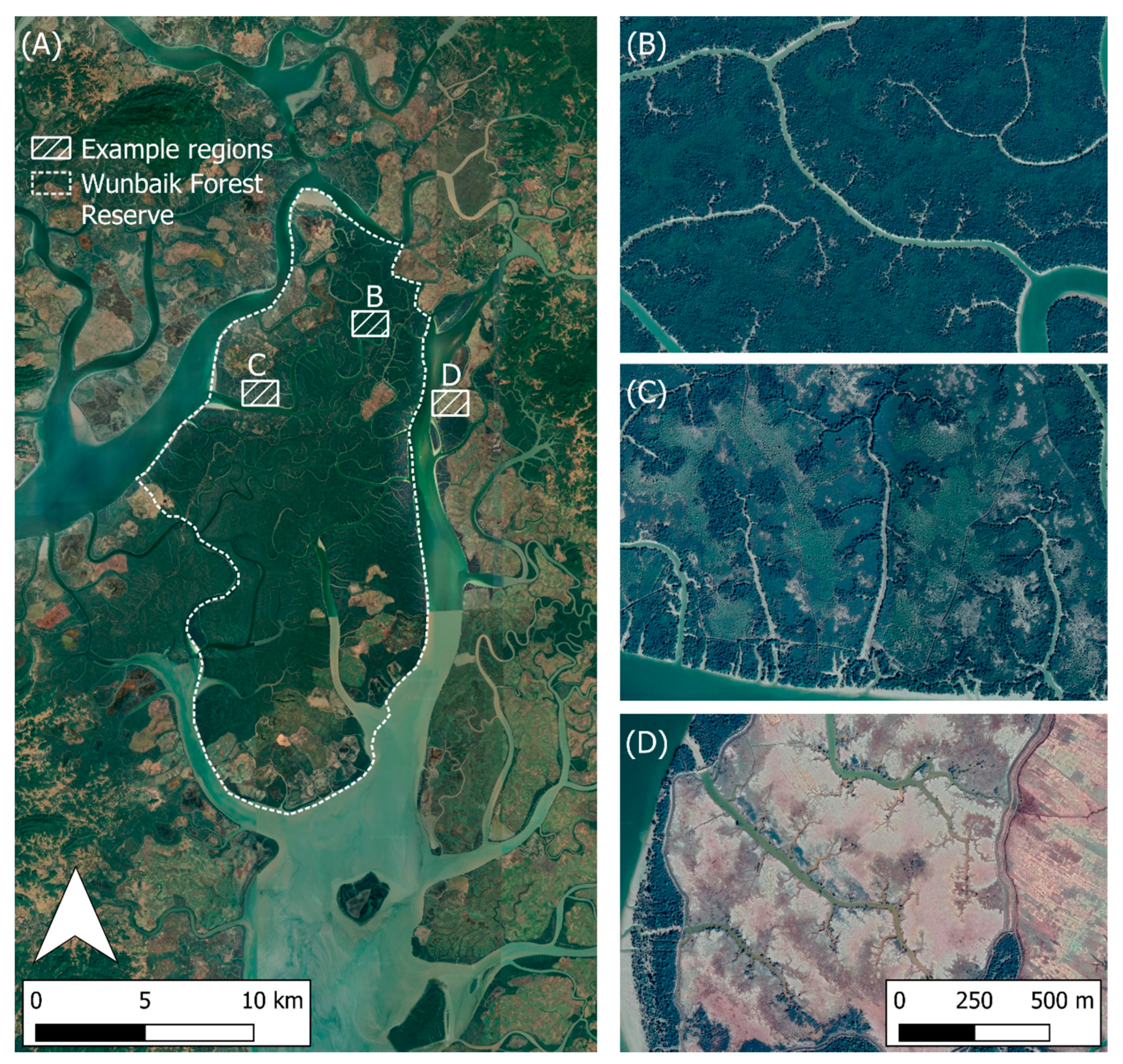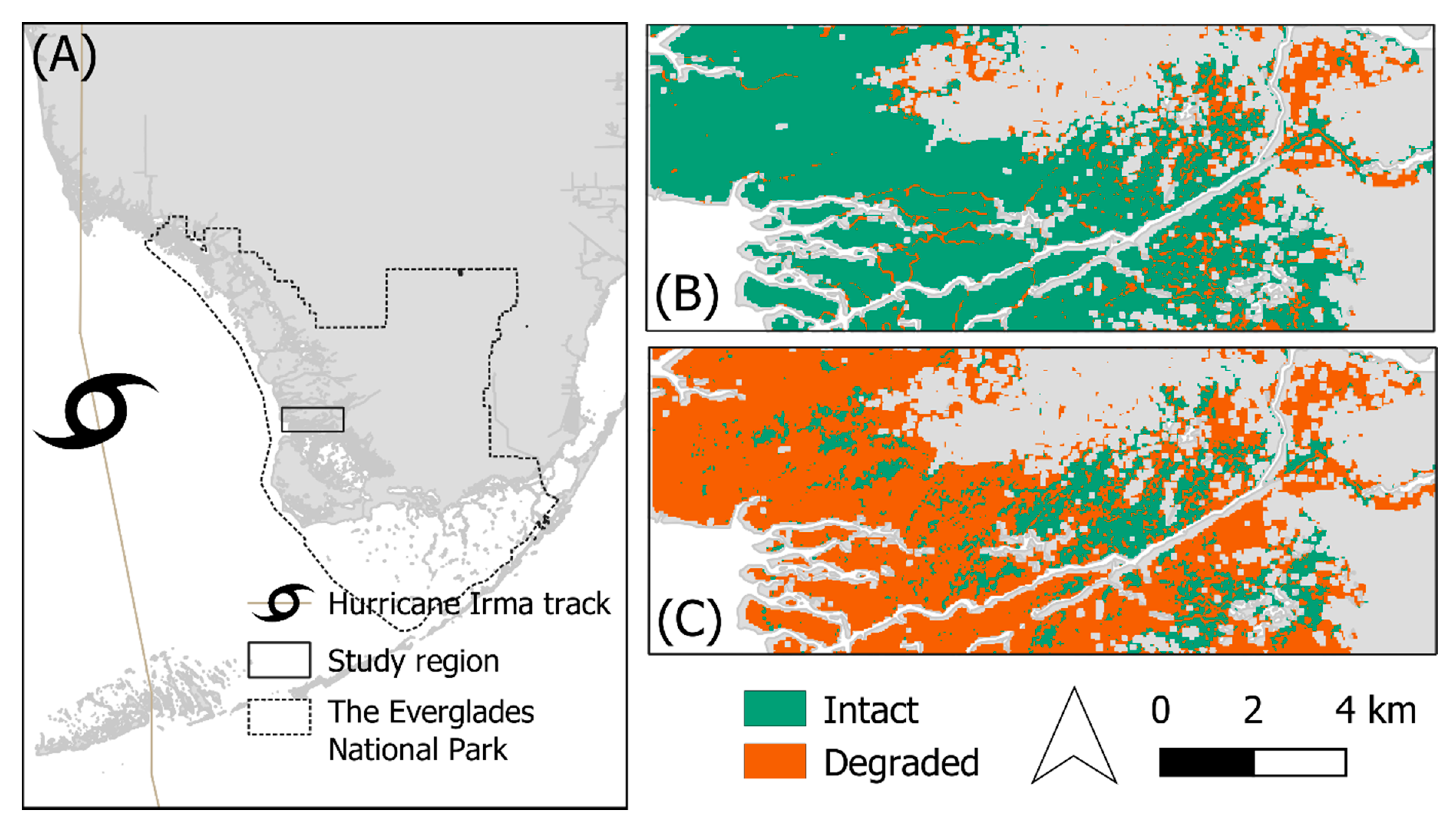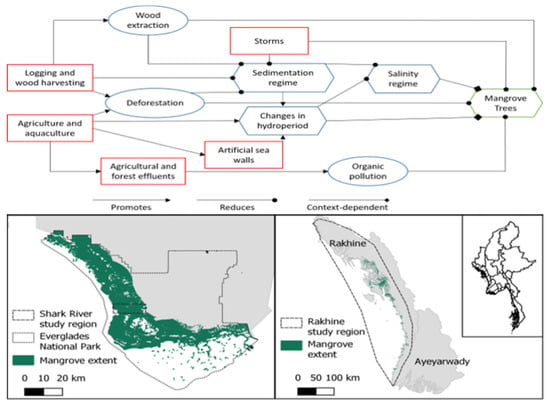1. Introduction
Ecosystem degradation is among the most important contributors to biodiversity loss [
1]. Degradation is often broadly defined as a departure from an ecosystem’s natural range of variability [
2] and can have substantial detrimental impacts on an ecosystems’ capacity to sustain services, such as carbon storage, resource provisioning, and water purification and regulation [
3,
4]. Such departures from natural variability thus lead to negative socioeconomic impacts at scales ranging from local to global [
5]. Measures estimating the extent of ecosystem degradation are a growing requirement of global environmental policy frameworks, including the post-2020 Global Biodiversity Framework [
6], the United Nations (UN) Sustainable Development Goals [
7], and the UN System for Environmental Economic Accounting (SEEA) [
8]. To support efforts to assess risks to global biodiversity, evaluate global conservation targets, develop spatially explicit conservation and restoration plans, and support environmental monitoring and management, there is an urgent need to develop spatially explicit and ecologically relevant maps of ecosystem degradation.
Degradation can be defined, conceptualised, and represented in different ways, and this inconsistency can cause confusion to researchers when trying to measure and map it. For example, decreased provision of ecosystem services can be used to represent degradation [
9]. This anthropocentric approach focuses primarily on benefits to humans and may neglect other important aspects of the ecosystem. Proximity to anthropogenic pressures and disturbances can also be used to infer degradation based on the assumption that these threats inherently cause degradation [
10]. Such threat maps can be useful to highlight areas requiring conservation action, but threat levels are not necessarily correlated with realised ecosystem degradation due to variable ecosystem responses to different threats [
11,
12,
13]. Lastly, direct changes to an ecosystem’s composition, including species assemblage and abundance [
14]; structure, such as canopy cover [
15]; or function, such as productivity [
16], can be used to represent degradation [
2,
17,
18]. This approach is more ecologically representative of the processes that underpin an ecosystem’s capacity to support biodiversity and deliver ecosystem services [
2]. On the other hand, an ecosystem that is not degraded can be seen as intact, healthy, or in an ecological condition that represents the ecosystem’s baseline state [
19,
20].
Maps of the distribution of ecosystem degradation may be developed from a range of data types and information sources, producing results with varying degrees of accuracies, coverage, and resolution. In situ data, such as field observations, are a common source of information about ecosystem degradation [
18], but their collection is typically labour-intensive, costly, and frequently limited in extent to local scales. Expert opinion is also used for mapping ecosystem degradation, but this is often qualitative and difficult to reproduce [
18]. To overcome these limitations, satellite remote sensing data are increasingly used because they provide a regularly collected data stream, often at the continental to global scale, suitable for monitoring environmental change [
21]. By leveraging the vast amounts of information available from satellite data, a range of analyses to investigate different aspects of ecosystem degradation are possible. Examples include: (i) time-series of single satellite-derived indices, such as the normalised difference vegetation index (NDVI) to identify changes in primary productivity [
16,
22]; (ii) temporal summaries of metrics to model changes in the physical structure of ecosystems [
23]; (iii) quantitative modelling of satellite spectral bands [
24]; (iv) generalised linear models to estimate ecosystem degradation [
25]; and (v) combination of threat maps with satellite-derived maps to identify disturbed ecosystems [
26].
Given the potential sources of data and methods available to ecologists, it is essential that any statistical models of degradation include predictor variables relevant to the study ecosystem’s components and processes, rather than simply including all possible data without proper consideration [
27]. In the context of mapping ecosystem degradation, a simplified conceptual model depicting an ecosystem’s primary components, interactions, and processes and identifying pathways to degradation can support the development of a suitable quantitative model [
2]. These conceptual models identify the core abiotic environment and the characteristic native biota of an ecosystem, the processes that connect these components, and the primary drivers of change that affect the system (such as threats) [
2]. By developing conceptual models, assumptions are explicitly stated, and the potential degradation pathways can be identified [
28,
29]. Crucially, conceptual models facilitate the selection of empirical data that are expected to have explanatory power or expected relationships with the processes that lead to ecosystem degradation. Following a process of conceptual model development for predictor variable selection is particularly important when developing models that could potentially use hundreds of data sources sourced from extensive earth observation archives.
Mangrove ecosystems occur globally along tropical and warm temperate coastlines and provide a wide range of ecosystem services, including acting as sources of food and fuel for local communities, providing nursery sites for ecologically and commercially important faunal species, contributing to climate regulation via high sequestration and storage capacities, and enhancing coastal protection from storm events [
30,
31,
32]. Early studies estimated that 35% of the world’s mangrove extent was lost between 1980 and 2000 [
33], though the annual rate of mangrove forest loss slowed to an average of 0.26%–0.66% globally between 2000–2012 [
34] and down to 0.13% between 2000–2016 [
35]. However, remaining mangrove ecosystems are in various states of degradation as a result of a range of natural and anthropogenic disturbances, including seawall construction, clearing for agri- and aquaculture, overfishing, pollution, loss of tidal connectivity, and climate change related disturbances such as sea level rise and extreme climatic events [
12,
13,
35,
36]. Despite their importance and wide range of threats they face, many remote sensing studies focus primarily on mapping mangrove ecosystem distribution and extent. Some studies used specific vegetation indices to infer mangrove health, and a few studies used hyperspectral data to classify mangroves into various health statuses [
37]. To our knowledge, there is currently no method of mapping mangrove ecosystem degradation using freely available satellite data with explicit ecological links between satellite variables and mangrove degradation.
In this study, we developed a quantitative, spatially explicit, and ecologically meaningful degradation model to estimate the extent of degradation for two case study mangrove ecosystems that were impacted by contrasting threatening processes. We used a conceptual model of mangrove ecosystems to identify satellite-derived variables for use as covariates, focusing on variables that can detect mangrove vegetation degradation. Using high resolution Google Earth imagery, we created a set of annotated point samples of mangroves as training and testing data, focusing on their canopy cover and deviation from natural variability. We then applied our degradation classification model to the two case study sites. Crucially, the workflow developed here can also be applied to other ecosystems.
4. Discussion
Despite the need for consistently quantified measures of ecosystem degradation [
2,
67], few methods exist that estimate the distribution of degradation at the ecosystem-scale without resource-intensive field data. We present a method that enables large scale assessments of ecosystem condition using freely available satellite data linked to a defined ecosystem conceptual, developing different classification models suitable for our two case study regions. We found that more than half of the mangroves in our Rakhine study area were identified as degraded or collapsed, while a single intense storm caused extensive mangrove degradation along Shark River. Our study highlights the feasibility of moving beyond area-based (i.e., ecosystem cover only) goals for conservation, which can greatly underestimate negative impacts of ecosystem change on biodiversity and dependent ecosystem services [
68] by quantifying the various states of mangrove degradation.
The two case studies used the same conceptual model to build two different classification models, with slight differences in the data included. Due to this, the mapped degraded classes in our two case studies may not be directly quantitatively comparable but follow the same conceptual definition and thus can both be used to investigate extent of mangrove degradation. Our models were both able to detect mangrove degradation in both study regions despite the different classification models and drivers of degradation. We found that the highest incidence of degradation in Rakhine mangroves were in the north of the study region, suggesting more extensive urban development in this region near to the state capital of Sittwe is leading to more extensive mangrove degradation. This result highlights the continued negative impact of anthropogenic activities on the mangroves in the region, including physical damage to the forests via wood harvesting and changes to water flows caused by the construction of dykes and seawalls, which are the initial stages in developing aquaculture [
44]. This degradation combined with the continued mangrove loss detected in the region [
43] reveals that Rakhine’s mangrove forests are likely to continue to be degraded if no supplementary conservation actions are implemented.
In Shark River, our model identified the widespread impacts of a single intense storm event, which caused widespread defoliation and mortality. Before the storm, we assumed that all mangroves within a single case study region had the same classification criteria; however, our model suggested that 5.1% of the study region was already degraded. Mangroves mapped as degraded were found further inland on the north-eastern side of the study region, where mangroves are dominated by the stunted
R. mangle, mixed with herbaceous vegetation (
Figure 5), and are consistently shorter than other mangroves in the study region due to being chronically stressed due to limited water or nutrient availability [
69]. Hurricane Irma in 2017 led to an additional 92.3% of the region’s mangroves becoming degraded, with degradation more extensive near the coastline as the storm winds caused more damage to the taller mangroves [
49]. The degradation observed here may particularly be a cause for concern if storms increase in frequency or intensity under climate change, particularly in regions with prolonged recovery rates [
49,
70].
In our classification models, we included annual summaries of various Landsat-derived indices along with ALOS-2 PALSAR-2 annual mosaic for Rakhine. The results showed that different variables were important in differentiating between intact and not-intact mangroves and collapsed and not-collapsed mangroves (
Table 6,
Table 7 and
Table 9). The importance of the mean measures for differentiating between intact and not intact mangroves suggest that the actual value of the indices is more important for intact mangroves, which likely have much higher NDVI and NDMI values. On the other hand, the stability of the values is more important when differentiating between whether mangroves have collapsed or not. The ALOS-2 PALSAR-2 data were also important in the intact-not-intact model, suggesting that it could have been a useful source of information for the Shark River analysis.
By using a conceptual model to select ecological-meaningful variables for our classification models, we can much more easily interpret the results of the variable importances from the models and can directly use them to investigate whether the model behaviour matches the mechanisms proposed to affect mangrove degradation (
Table 2). Moreover, building a conceptual model prior to classification highlighted the data required to map mangrove degradation and thus any data gaps and limitations when no suitable data were available as input into the classification models. In the case studies here, no suitable data to represent evaporative stress were included in our classification models despite their potential importance in detecting mangrove degradation (
Table 1) [
46].
Despite providing ecologically meaningful inferences from the developed conceptual mangrove ecosystem model and high quantitative model accuracies here, our present approach has scope for further development. The data we used as explanatory variables in our models were snapshots and did not take long-term (>one year) temporal trends into account. As a result, potential ecosystem recovery was not assessed for either case study. As such, our results here did not capture mangrove recovery in Shark River [
49]. Similarly, our results for the Rakhine mangroves did not explicitly show a lack of recovery from the anthropogenic threats. To produce results that track ecosystem degradation over longer time periods, the models trained here can be applied to data collected by the same satellite sensors at regular time intervals. Results produced in this manner allow us to capture changes in mapped degradation, revealing potential recovery or continued degradation through time. Using time-series maps produced this way can also help us differentiate between mangroves that originally had close canopies and became degraded and mangroves that naturally have open canopies.
Our models had accuracies of 77% and 79% and overestimated the extent of mangrove degradation for both regions (
Table 3). Inaccuracies were primarily due to the relatively coarse spatial resolution of the underlying data, which is several times larger than a single tree canopy. In cases where there were multiple land cover types within a single pixel, such as mangroves along water courses (water and mangrove in a single pixel), or when there were two or more degradation classes within a single pixel (for example, the border between a degraded and intact mangroves), the model tended to classify these pixels as degraded. Additional commission errors in the degraded class appeared to be due to pixels that were initially misclassified in the GMW base map (e.g., other forest types, greenery in villages). Our models assumed that all input pixels were mangrove pixels, meaning these pixels misclassified by GMW did not fit into any of the criteria listed in
Section 2.3. These pixels were labelled as collapsed by assessors, though it was unlikely for the models to be able to effectively classify them, as they were not developed to classify non-mangrove land cover types. Additionally, the high-resolution Google Earth imagery used for training and validation were only available during the dry season, but the data used as covariates in our classification models were summarized over the entire year after cloud masking. This could potentially bias our results, though it is unlikely mangroves will appear substantially different throughout the year in high-resolution imagery. Despite these misclassifications, we believe overestimating degradation is preferable to the alternative, as it provides more conservative estimates following a precautionary approach.
Given the above sources of classification error, future development of the models can improve the accuracy in several ways. Firstly, we can integrate an additional step by explicitly modelling other land cover classes that help reduce uncertainties in the underlying mangrove cover datasets. Secondly, data with finer spatial resolution, ideally those finer than a single tree canopy, will help us and understand and minimise errors due to mixed pixels, though this can lead to additional sources of errors from shadows and noise. Thirdly, producing annual maps of mangrove degradation using the same models can allow us to compare extent of degradation through time, providing information of potential mangrove degradation and recovery. Lastly, modelling a continuous class of degradation (e.g., from low to high levels), as opposed to simply classifying degradation into a single class, will allow us to capture the severity of degradation as a continuous response variable. This will likely require extensive field data collected explicitly quantifying the (relative) severity of degradation as the objective. Examples will be data that capture ecosystem composition, such as plant surveys specifying species richness, ecosystem structure, such as canopy cover measurements using a Cajanus tube [
71], and ecosystem function, such as estimating plot level net primary productivity. Additionally, field data can also be incorporated as explanatory variables, providing additional information that captures the specific components highlighted by the conceptual model. For example, data for soil salinity within mangrove forests at various stages of degradation can be used to provide information about the salinity regime to the models, while tide gauges can provide precise information on the hydroperiod of the study site. Not only will these data increase the accuracy of the models, spatially explicit maps of ecosystem degradation severity will also provide additional information that the classification approach used here cannot provide.













